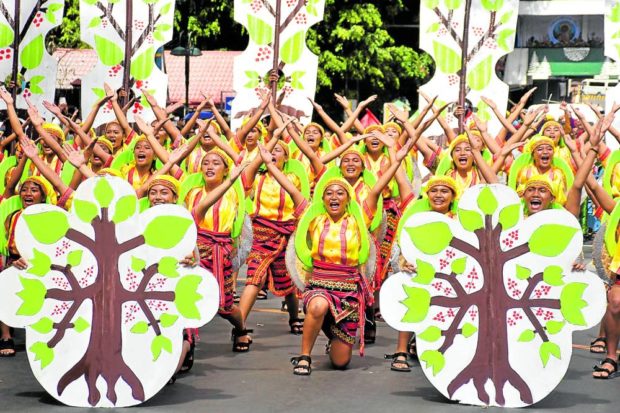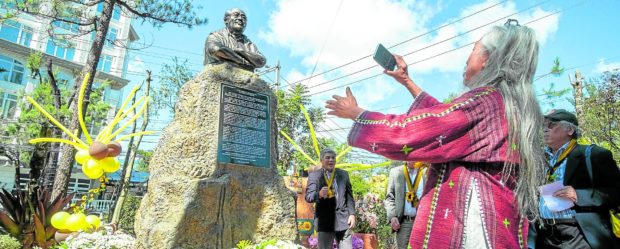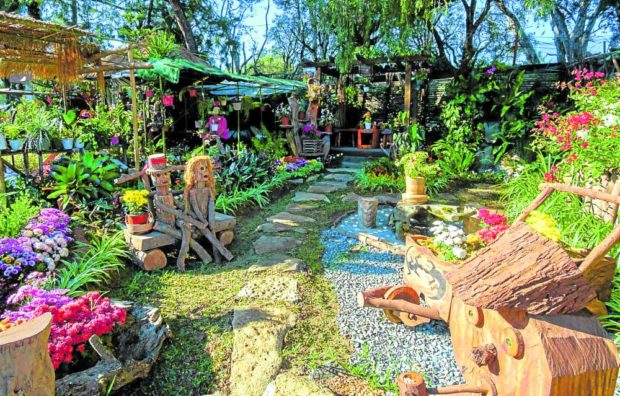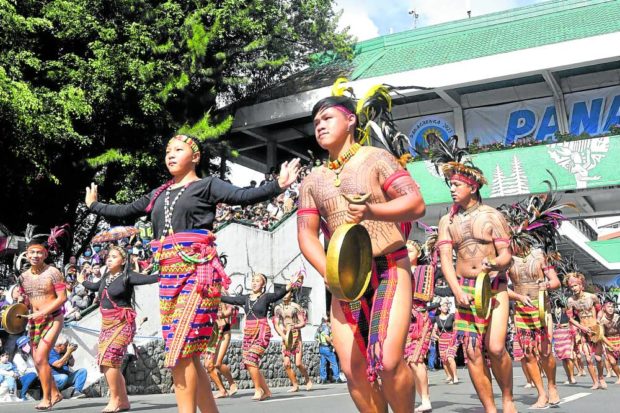Baguio back in bloom

FLOWERS AND SMILES Dressed in flower-inspired costumes, every performer flashed their brightest smile during the street dancing parade of this year’s Panagbenga (Baguio Flower Festival) on Saturday, the first in-person staging of the summer capital’s tourism event during the pandemic. (Photo by WILLIE LOMIBAO / Inquirer Northern Luzon)
BAGUIO CITY, Benguet, Philippines — When the late Damaso Bangaoet Jr. and his closest friends sat down in 1995 to plan a festival that could promote Baguio, the lawyer studied the best parts of the grand cañao (community feast) that used to be staged in the city during martial law, the centuries-old Pasadena Rose Parade and its flower-themed floats in California and Brazil’s Rio Carnival.
The idea came up because the summer capital had just recovered from the July 16, 1990, Luzon earthquake that tore down most of the city’s infrastructure. The disaster forced many Baguio families to flee, with some even deciding to migrate overseas.
The city’s economy had also plummeted, so luring back residents and tourists was the paramount task advocated by civic leaders and businessmen at the time, according to Bangaoet in a 2012 Inquirer interview.
Eventually, Bangaoet’s informal group put together a festival that promoted Baguio’s Cordillera roots, the city’s cool climate and Benguet province’s flowers, which he pitched to the board of directors of the now defunct John Hay Poro Point Development Corp. (JPDC).
JPDC was the estate manager of Camp John Hay, which Bangaoet would eventually lead as president in 2000.
According to his wife, Laurel, Bangaoet also shopped the idea around to draw the support of the city government, university and college officials and business owners in the city center.
“He wanted a Panagbenga done for the people, by the people,” she said.

FESTIVAL’S FATHER National Artist for Film Kidlat Tahimik takes a photo of a bust dedicated to the late lawyer Damaso Bangaoet Jr., the man who conceptualized and developed Panagbenga in the mid-1990s. The bust, now standing at Panagbenga Park was unveiled on Feb. 24 by Bangaoet’s friends and family. —NEIL CLARK ONGCHANCO
Economic solution
Baguio’s subsequent population growth has been attributed to the promise offered by the Baguio Flower Festival or Panagbenga, an Ibaloy term for “season of blossoming,” which became one of the country’s biggest tourism attractions in just a decade, and was proof of the brilliance of Bangaoet’s initiative.
On Friday, a bust dedicated to Bangaoet was unveiled, honoring him as the “Father of Panagbenga,” a day before the festival restaged its street dancing parade on Saturday, and the floral floats parade on Sunday.
The parades have not been staged since 2020, when all crowd-drawing activities were halted due to community lockdowns and mobility and travel restrictions imposed by the government to stop the spread of COVID-19.
This year’s festival is repeating its original mandate of reviving the economy, not only in the city but in the rest of the Cordillera.
The region requires P33 billion to make up for its 2020 economic contraction of 9.9 percent. In January, the region also reeled from a 7.9-percent inflation rate due to high food prices, according to the Philippine Statistics Authority (PSA).
But the return of the parades came at a very good time, Jovita Ganongan, Cordillera director of the Department of Tourism, tells the Inquirer.

A mix of indigenous Cordillera —NEIL CLARK ONGCHANCO
Revenge travel
Since late 2021 and the whole year of 2022, Baguio has been benefiting from a unique travel phenomenon where visitors return frequently even beyond the traditional peak tourist months of November to April, she notes.
“This phenomenon appears to be revenge travel for people who were stuck at home for two to three years,” Ganongan says.
Travel time to Baguio from Metro Manila had also been cut from about seven hours to just four hours due to the expansion of the Tarlac-Pangasinan-La Union Expressway. A direct flight from the Visayas and Mindanao via the Philippine Airlines’ Baguio-Cebu route was also launched late last year.
In 2019, tourism expenditures, or the estimated amount spent by domestic tourists in the Cordillera, were P9.69 billion, according to the PSA.
The region’s tourism receipts dropped to P1.8 billion in 2020 when leisure travel was restricted in March, when the pandemic was declared. Baguio that year represented 85 percent (P1.54 billion in tourism receipts) of the region’s domestic tourism expenditures, PSA records show.
A 2015 study posted on the PSA website says the flower festival attracts tourists who are in their mid-20s up to 40s.
These tourists display a “love for the culture and the arts [and] have a sense of adventure and were ready for a road trip at a moment’s notice,” according to the case study, “A Snap Shot of the Market Niche of the Panagbenga Festival Tourists,” by researchers Lee Majors Fajilan and Christine Manipon.
Since Baguio serves as a gateway to the rest of the Cordillera provinces, the regional tourism industry hopes revenge travel during Panagbenga would bring domestic tourists to interior towns, which have also resumed their own community festivals.
This month alone, equally popular tourism destination Sagada town in Mountain Province restaged its Etag (smoked pork) Festival from Feb. 2 to Feb. 5, while Apayao province held its Say-am Festival from Feb. 10 to Feb. 14, complete with its own street dancing and float parades.
Kalinga, Ganongan says, made its international mark when it broke the Guinness World Records for the largest gong ensemble and largest clay pot dance during its Bodong Festival on Feb. 16.

A contemporary defines costumes, performances and the character of Panagbenga’s street dancing parade on Saturday, one of the crowd-pleasing events in the annual flower festival. —PHOTO BY WILLIE LOMIBAO
Urban decay
The flower festival is also significant in Baguio’s efforts to curb urban decay and address climate change.
The festival operations already address issues like overcrowding and waste management by regulating parade audiences and an annual week-long festival street bazaar called “Session Road in Bloom,” said Andrew Pinero, spokesperson for Baguio Country Club, whose volunteers have been providing festival manpower for decades.
But for issues like traffic, the parades would provide data so the Baguio government could enact long-term measures, he adds.
On Feb. 14, Panagbenga launched a fluvial parade at the “blue” Burnham Lake, which is slowly being achieved using organic algicide to clean the century-old tourist attraction.
The “blue-ming” lake is actually one of Baguio’s environmental measures to reduce its carbon footprint, shares city environment officer Rhenan Diwas.
“Climate change is no longer a distant threat. It is already happening now,” laments Mayor Benjamin Magalong at the summit.
He points to a “glaring increase in Baguio’s carbon emissions brought by transportation, household (activities) and waste generation that contribute significantly to our greenhouse gas emissions.”
At the Feb. 13 Baguio executive legislative assembly, Kazakhstan-based smart traffic firm Sergek Development concluded that “traffic contributes to 72 percent of air pollution in the center of Baguio,” when it presented results from its “proof-of-concept” trial run of an artificial intelligence-managed traffic system here. It has been collecting traffic data during this year’s monthlong festival.